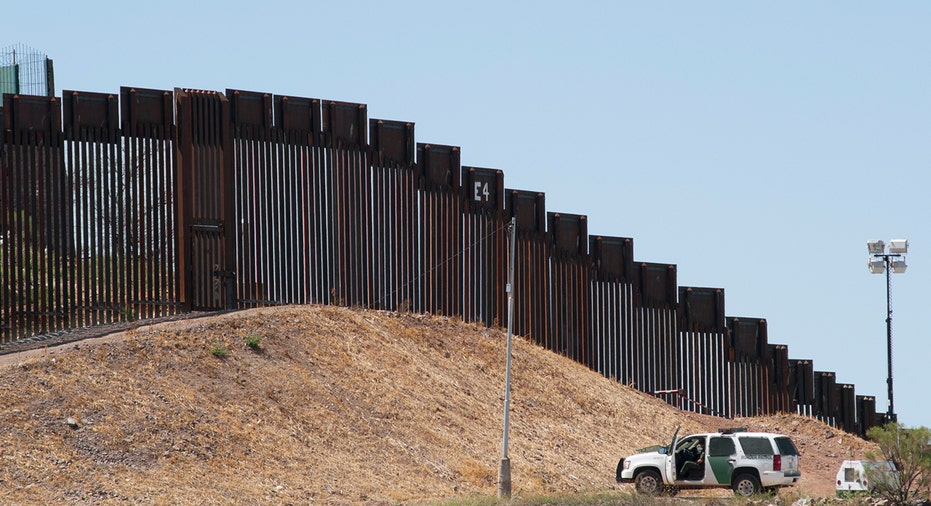Trump’s Border Battle: How to Pay for the Wall

On Tuesday the Department of Homeland Security (DHS) released a memo containing sweeping new immigration guidelines, and included were details on U.S. Customs and Border Protection’s (CBP) agenda for plans to build a wall on the U.S.-Mexico border.
“CBP is taking immediate action in response to the president’s executive order. We have identified locations near El Paso, Texas, Tucson, Arizona, and El Centro, California, where we will build a wall in areas where the fence or old brittle landing-mat fencing are no longer effective,” the DHS fact-sheet memo said. “The Border Patrol is also in the midst of an operational assessment, which will identify priority areas where CBP can build a wall or similar physical barrier on the border where it currently does not exist.”
According to the release, the CBP’s findings will “inform DHS’s strategy to obtain and maintain operational control of the southern border,” and are expected to be presented to the agency “well before” the 180-day deadline for DHS to produce a comprehensive study of the security of the southern border.
White House Press Secretary Sean Spicer addressed the potential financing of DHS’s new plan to crackdown on illegal immigration during Tuesday’s press briefing, specifically referring to the hiring of 15,000 new border patrol agents.
“Right now, ICE and DHS in particular as well as CBP, are looking at what this is going to cost and how much,” he said which will be followed by “then figuring out how much can be handled through reallocation of resources and how much we can save maybe on other areas, but also work with Congress” said Spicer.
Spicer’s comments follow the campaign style rally in Melbourne, Florida on Saturday, where President Trump renewed his campaign promise to build a wall along the southern border.
“We've taken historic action to secure the southern border. And I've ordered the construction of a great border wall, which will start very shortly,” said Trump.
While the DHS memo noted that “CBP has identified funding to begin immediate construction and is working with the Administration in these efforts,” a new report from the Center for Immigration Studies (CIS) released last week suggests the wall, over time, could pay for itself.
According to Steven A. Camarota, the author of the study, each illegal who enters the U.S. from Mexico represents an average fiscal burden of roughly $74,722, and if just “9 to 12 percent of those expected to successfully cross in the next decade [were deterred], the fiscal savings would equal the $12 to $15 billion cost of the wall.”
But some experts say not so fast. Camarota’s findings are based off a National Academy of Sciences study, and some of the experts who were on the NAS panel disagree with Camarota’s methodology.
“There’s a lot of misestimates in their calculations and they don’t really lay out exactly how they did it,” Professor of Public Policy at University of Southern California and member of the NAS panel Dowell Myers said. “They kind of scramble it together, so it’s a little hard to say what they did.”
There are two key factors that Myers’ believes skew the “calculations by a factor of four.”
For starters, the “9 to 12 percent of those expected to successfully cross in the next decade” is based on the 170,000 that entered illegally in 2015 from a Department of Homeland Security report in May.
Since 2000 there has been a 90 percent decline of illegal border crossers between ports of entry, and to hold the 170,000 as a constant over the next decade doesn’t accurately reflect the trend in the DHS report.
For example, in 2013 there were 360,000 illegal border crossers, in 2014 that number dropped significantly to 210,000, followed by the 170,000 in 2015.
The CIS study also accounts for a border wall cost of $12 to $15 billion, when the Department of Homeland Security’s most recent estimate has the price of the wall at $21.6 billion.
“So, its [CIS report] probably got, I estimate roughly twice as many future border crossers as justified and half as much wall costs as justified, that’s at the base of all the calculations,” said Myers.
As for the $74,722 fiscal burden that undocumented immigrants represent over a lifetime, it’s a little “misleading,” said Kim Ruben, senior fellow at the Urban Institute and a member of the NAS panel.
“A lot of the reason that they’re a negative cost, especially at the federal level, this is a little different at the state level, has to do with the fact that we’re running a trillion-dollar deficit,” Ruben said.
She went on to add, “as long as we have deficits, everybody looks like they’re costing the government money, because they do, because were not raising enough in taxes.”
While the NAS study didn’t differentiate between undocumented and documented immigrants, it found that immigrants are actually contributing more to the U.S. economy than they’re taking as welfare and Ruben says that undocumented immigrants still pay sales taxes, property taxes, and in some cases even income taxes.
Hector, an undocumented immigrant whose name has been changed to protect his identity, has lived in the United States for the past 16 years. Due to economic reasons, he left his home in Mexico and walked across the border to the U.S. through Tijuana with a Coyote.
Hector has since developed his life stateside – he’s a homeowner, has a social security card, and holds a job shipping produce.
In Hector’s mind, the wall will have more of an emotional impact than anything else.
“Everyone is going to jump the wall,” said Hector. “So, what it is going to be is for those eastern Europeans who remember the Berlin Wall; it’s going to be a psychological thing to them, a reminder of the Berlin Wall that used to separate East and West Germany.”



















